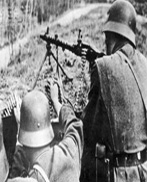History
History
As a member of the 352. Infanteriedivision, you’ll be portraying a unit rich in history. The division was formed in November 1943 as part of Wehrkreis XI (military district 11), headquartered in the city of Hannover. The division cadre were survivors of the following units:
 321st Infantry Division:
321st Infantry Division:
Home stationed at Hannover, Wehrkreis XI
Contained the 588th, 589th, and 590th GR
1940: Activated at Abbeville; Dec. 1942: Eastern Front, part of Army Group Center, fought at Kursk, suffered heavy losses. Most of the Division support troops were transferred to the newly forming 352. Division.
 546th Grenadier Regiment:
546th Grenadier Regiment:
Part of the 389th Inf Div, home stationed at Hesse, Wehrkreis XII
1941-1942: Eastern Front, fought in the winter drive to and across the Don River, fought at the Volga River, then at Stalingrad. The survivors from Stalingrad formed the cadre for the 1st and 2nd battalions of the 916th Grenadier Regiment, whom we portray.
Most of the core junior and senior NCO’s were hardened Russian Front veterans transferred from shattered or disbanded divisions in the east. Likewise, most of the senior officer staff were experienced men. But the vast majority of men that made up the division consisted of troops with little or no combat experience. Fresh troops were drafted from the Hannover area, as well as Volksdeutsche recruits; Polish and Czech Germans, Alsatians (French Germans), and Russian volunteers. Not only did most of these men lack combat experience, and suffered from food shortages in Germany, many of them did not even speak German!
Lack of supplies meant that by March 1944, the unit had held just 3 live-fire exercises and each Grenadier had been able to throw just two hand grenades. The few transport vehicles available were of foreign designs that had no spare parts available, and driver training was further hampered by fuel shortages.
Rommel placed the 352. Infanteriedivision at Normandy, between the 709. Infanteriedivision at Cherbourg and the 716. Infanteriedivision at Caen.
914 Grenadier Regiment was stationed west at Point du Hoc and in the Carentan Canal area, 915 GR was held as Armee reserve, and 916 GR was at a central location on, and one kilometer behind, Omaha Beach.
352. Infanterie-Division Gliederung:
(May, 1944)
Grenadier-Regiment 914
Grenadier-Regiment 915
Grenadier-Regiment 916
Artillerie-Regiment 352
Three batallions of 105mm guns, and
one batallion of 150mm guns.
Divisions-Füsilier-Batallion 352
Mounted infantry, mostly using
bicycles and horses.
Pioneer-Batallion 352
Combat engineers
Divisions-Nachtrichten-Abteilung 352
Signals detachment
|
Feldersatz-Batallion 352
Division replacement batallion, staffed by
experienced combat staff for training
replacements and wounded men
returning to the 352.
Panzerjäger-Abteilung 352
Anti-tank detachment, with 14 Marder II,
10 StuG III, and Opel trucks mounting 37mm
PaK guns.
Divisions-Nachschubführer 352
Supply detachment
Nebelwerfer Batterie 100
Ost-Batallion 621
Special Notes:
50% of the officer corps had not seen combat
30% of NCO positions were empty
1500 Russian Hilfswillige Troops
|
When it was clear the enemy troops were landing in force, all available units were rushed forward to the line, mostly on foot or bicycle. Hardened bunkers (Widerstandsnest) on or near the beach opened fire and continued to fire until the men inside were either dead or out of ammunition. Artillery Regiments 352 and 1275 had presighted every inch of the landing area, and poured a continuous stream on concentrated and harrasing fire until they too, were out of ammunition or in danger of encirclement.
Capt Edward McGregor, US 1st Inf Div
“Assault units desintegrating. Very heavy losses. Enemy fire prevents crossing of the beach line. Landing units bunching up in a very confined area. Engineers unable to clear paths through minefieldsand cannot destroy beach obstacles. Elements of the… 352nd Infantry Division identified.”
Battle Report, US 5th Corps, 08:30a.m. June 6, 1944
 Most of the division did not eat or sleep until June 10th. Fighting was continuous, and a total lack of motorized transport, and constant air attacks meant that all travel was by foot or bicycle. By D-Day +1 the remaining forces of 352 were facing well supplied armored and infantry units advancing from the beaches, and could not hold them back. By D-Day +4 a huge portion of the 352’s fighting strength had been either killed or captured, and it ceased to be an effective fighting unit. Small pockets of men continued to fight, and were folded into independant kampgruppe or other local units. Remnants were later captured in the Falaise Pocket in July.
Most of the division did not eat or sleep until June 10th. Fighting was continuous, and a total lack of motorized transport, and constant air attacks meant that all travel was by foot or bicycle. By D-Day +1 the remaining forces of 352 were facing well supplied armored and infantry units advancing from the beaches, and could not hold them back. By D-Day +4 a huge portion of the 352’s fighting strength had been either killed or captured, and it ceased to be an effective fighting unit. Small pockets of men continued to fight, and were folded into independant kampgruppe or other local units. Remnants were later captured in the Falaise Pocket in July.